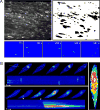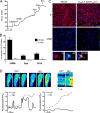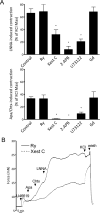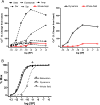Functional Tuning of Intrinsic Endothelial Ca2+ Dynamics in Swine Coronary Arteries
- PMID: 26838791
- PMCID: PMC4818197
- DOI: 10.1161/CIRCRESAHA.115.308141
Functional Tuning of Intrinsic Endothelial Ca2+ Dynamics in Swine Coronary Arteries
Abstract
Rationale: Recent data from mesenteric and cerebral beds have revealed spatially restricted Ca(2+) transients occurring along the vascular intima that control effector recruitment and vasodilation. Although Ca(2+) is pivotal for coronary artery endothelial function, spatial and temporal regulation of functional Ca(2+) signals in the coronary endothelium is poorly understood.
Objective: We aimed to determine whether a discrete spatial and temporal profile of Ca(2+) dynamics underlies endothelium-dependent relaxation of swine coronary arteries.
Methods and results: Using confocal imaging, custom automated image analysis, and myography, we show that the swine coronary artery endothelium generates discrete basal Ca(2+) dynamics, including isolated transients and whole-cell propagating waves. These events are suppressed by depletion of internal stores or inhibition of inositol 1,4,5-trisphosphate receptors but not by inhibition of ryanodine receptors or removal of extracellular Ca(2+). In vessel rings, inhibition of specific Ca(2+)-dependent endothelial effectors, namely, small and intermediate conductance K(+) channels (K(Ca)3.1 and K(Ca)2.3) and endothelial nitric oxide synthase, produces additive tone, which is blunted by internal store depletion or inositol 1,4,5-trisphosphate receptor blockade. Stimulation of endothelial inositol 1,4,5-trisphosphate-dependent signaling with substance P causes idiosyncratic changes in dynamic Ca(2+) signal parameters (active sites, event frequency, amplitude, duration, and spatial spread). Overall, substance P-induced vasorelaxation corresponded poorly with whole-field endothelial Ca(2+) measurements but corresponded precisely with the concentration-dependent change in Ca(2+) dynamics (linearly translated composite of dynamic parameters).
Conclusions: Our findings show that endothelium-dependent control of swine coronary artery tone is determined by spatial and temporal titration of inherent endothelial Ca(2+) dynamics that are not represented by tissue-level averaged Ca(2+) changes.
Keywords: calcium signaling; coronary vessels; myography; potassium channels; substance P.
© 2016 American Heart Association, Inc.
Figures








Comment in
-
No Static at All: Tuning Into the Complexities of Ca2+ Signaling in the Endothelium.Circ Res. 2016 Apr 1;118(7):1042-4. doi: 10.1161/CIRCRESAHA.116.308519. Circ Res. 2016. PMID: 27034269 Free PMC article. No abstract available.
References
-
- Drexler H, Zeiher AM. Endothelial function in human coronary arteries in vivo. Focus on hypercholesterolemia. Hypertension. 1991;18:II90–II99. - PubMed
-
- Konidala S, Gutterman DD. Coronary vasospasm and the regulation of coronary blood flow. Prog Cardiovasc Dis. 2004;46:349–373. - PubMed
-
- Sitia S, Tomasoni L, Atzeni F, Ambrosio G, Cordiano C, Catapano A, Tramontana S, Perticone F, Naccarato P, Camici P, Picano E, Cortigiani L, Bevilacqua M, Milazzo L, Cusi D, Barlassina C, Sarzi-Puttini P, Turiel M. From endothelial dysfunction to atherosclerosis. Autoimmun Rev. 2010;9:830–834. - PubMed
-
- Kawano H, Ogawa H. Endothelial dysfunction and coronary artery spasm. Curr Drug Targets Cardiovasc Haematol Disord. 2004;4:23–33. - PubMed
Publication types
MeSH terms
Substances
Grants and funding
LinkOut - more resources
Full Text Sources
Other Literature Sources
Miscellaneous

